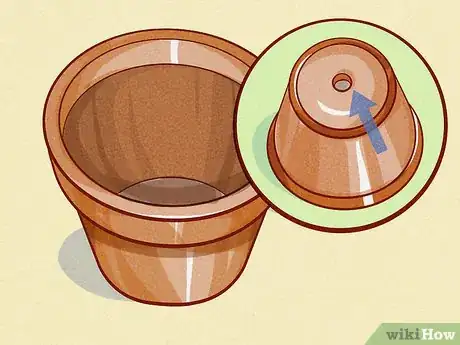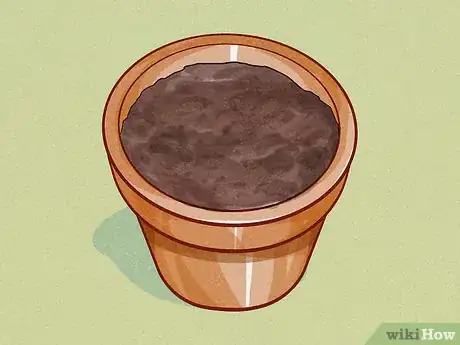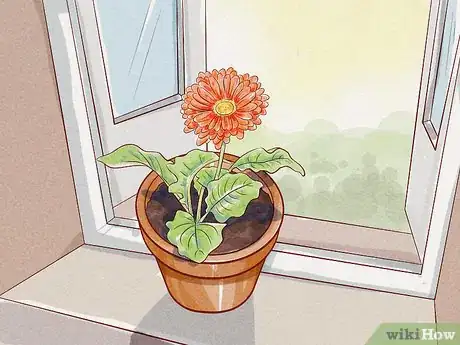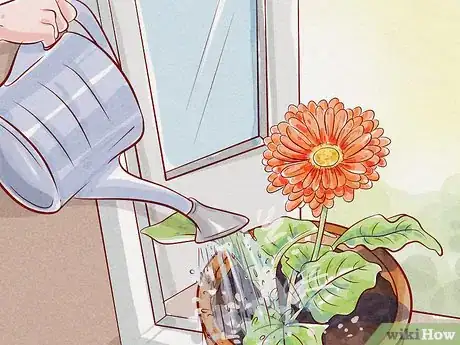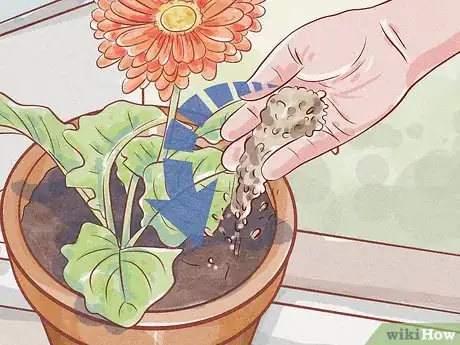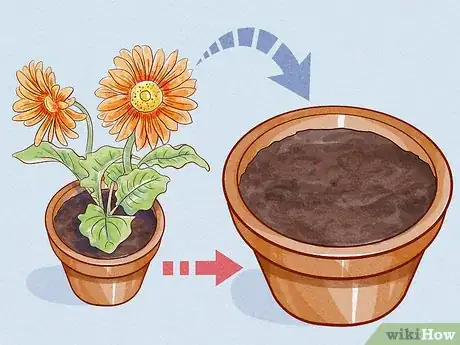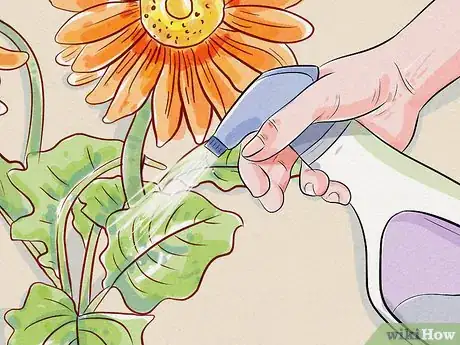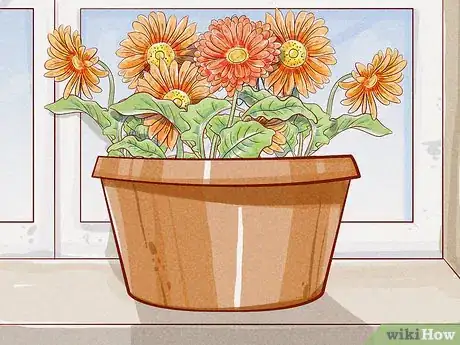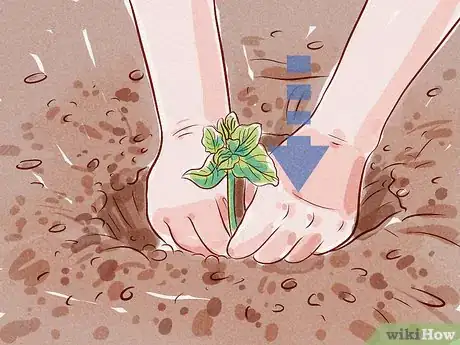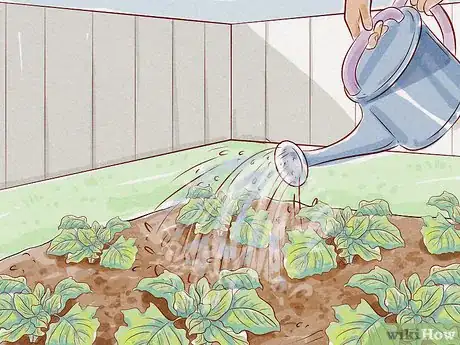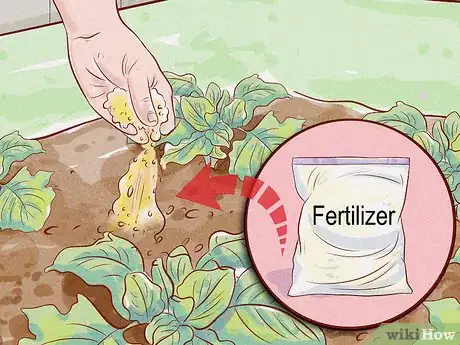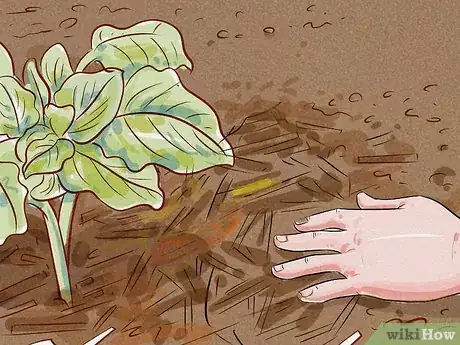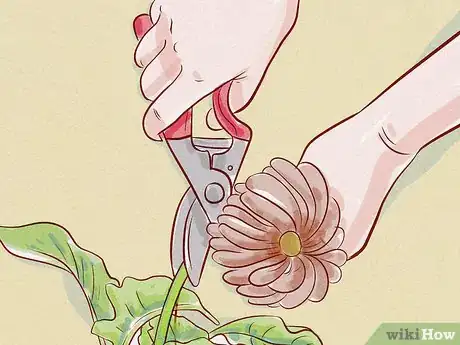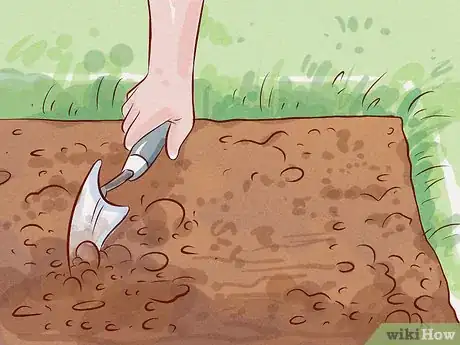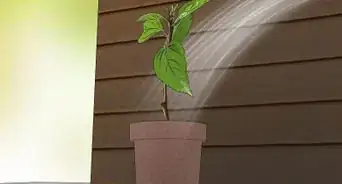wikiHow is a “wiki,” similar to Wikipedia, which means that many of our articles are co-written by multiple authors. To create this article, 11 people, some anonymous, worked to edit and improve it over time.
There are 9 references cited in this article, which can be found at the bottom of the page.
This article has been viewed 92,848 times.
Learn more...
With attractive, colorful flowers and a large center eye, gerbera daisies are a great addition to any garden or home. They come in a variety of colors including purple, pink, cream, and red and are popular indoor or outdoor South African plants.
Steps
Caring for an Indoor Plant
-
1Pick a container with good drainage. Gerberas must be in a pot with at least one drainage hole to avoid root rot, crown rot, and powdery mildew which occur when the soil is constantly wet and the plant is sitting in water. However, having even more holes on the bottom will be even better.
-
2Add the ideal potting soil mix. It's best to have fresh, high-quality potting soil. Fill the container with about 3 inches (7.6 cm) of the soil. Put in the plant and add more soil until the crown (where the stem meets the roots) is slightly above the soil. Don't cover the crown, or your daisy is likely to suffocate.
- Modern soils allow water to flow out of the drainage holes rather than be retained at the roots. This is necessary so that your plant doesn't experience root rot or other diseases.
Advertisement -
3Keep your plant in a spot with enough light. Near a sunny window, there's adequate sunlight, but the temperatures may be too high and end up burning the leaves. However, without enough sunlight, you'll have plenty of leaves but no blooms. Morning sunlight is ideal, but be sure to keep you gerbera out of bright light during the afternoon. They can tolerate cool temperatures, but find it hard to survive in temperatures higher than 70 °F (21 °C).[1]
- If your plant is located in indirect light, make sure it gets it the whole day. Turn on overhead lights or other lamps nearby, particularly during the winter.
-
4Water your gerbera deeply whenever the top inch of soil feels dry to the touch. If the soil is still moist, leave the plant for a day or two. Thoroughly soak the roots of the plant, but keep the leaves as dry as possible. Make sure the pot is thoroughly drained before putting it back on a saucer or drip tray. Otherwise, the plant's roots may rot in the soggy soil.[2]
- During the winter months, you should water it less often, but avoid letting the soil dry out completely.
-
5Use fertilizer to give your plants a boost in growth. For indoor plants, it's best to use a fertilizer that is formulated for blooming parts. Follow the instructions on the package as to how much fertilizer to use based on the size of your container. Fertilize your daisy during the growing season (mid-spring to early summer), but avoid doing so otherwise. [3]
-
6Remove wilted blooms. As the flowers start to wilt and fade, pinch or cut off the stem just next to the flower. Do this with all the dead or dying flowers on the gerbera. This is also referred to as deadheading the plant and will focus the development of the plant into growing more beautiful blossoms rather than producing seeds. It maintains the plant's appearance while also potentially allowing the second bunch of flowers to come out.[4]
- Bugs may pester your gerbera if you do not deadhead it.
- Start doing this early, such as around late spring, and repeat the process every couple of days to keep your plant in the best shape possible.
- If you'd like to keep flowers in a vase, cut them off when they're still fresh and keep them in water. They should last for several days.
-
7Repot your gerbera if it begins to multiply. Once the plant begins looking crowded in its pot, it will need to have more space. Pick a pot that's a size larger than your current one with at least one (preferably more) drainage hole at the bottom. Fill it with 3 inches of potting soil. Hold the stem with your fingers while also covering the top of the pot and turn it upside down. The plant along with some soil should slide out, but if it doesn't, you can knock the pot against another surface to turn the plant loose. Transfer the plant to the larger pot and add soil until the top of the roots sit an inch lower than the rim of the pot. Water your replanted gerbera daisy until it begins dripping from the drainage hole(s).[5]
- When you take the daisy out, you can examine the roots. Trim off any that appear diseased or rotten.
- Don't cover the crown (where the main stem meets the roots) when adding soil.
- The plant might wilt slightly following the repot, but will perk up again within a week or two with proper care.
- Although gerberas don't survive repotting very well because they have deep root systems, suffocating them in a small pot will not help either.
-
8Deal with pests that infest your plant. Gerberas may be infested by common household pests like mites or aphids. Spray your plant with an insecticidal soap according to the manufacturer's instructions.[6] Monitor your plants carefully so that you can tackle the problem before they take over and the problem gets severe.
- You may use an organic insecticidal soap if you wish.
Caring for an Outdoor Plant
-
1Pick the right spot for your gerbera. It should get direct sunlight in the morning and be shaded in the afternoon. Although they prefer bright sunlight, it's best to keep them out of intense light, especially in hot climates.
-
2Plant your gerbera correctly. Move them outside only when all risks of spring frosts are gone. Spade the soil to a depth of 8–10 inches (20–25 cm) and add a layer of organic matter like manure or compost. Leave a space of 18–24 inches (46–61 cm) between each plant if you have multiple. Make sure that the crown of the plant (or where the stem meets the roots) is just above ground level so that your gerbera doesn't suffocate.
-
3Water your plant if there is no rain for about a week. You can also water when the top of the soil and the crown (the place where the stem meets the roots) of the plant are dry. Do this only in the morning so that the leaves get a chance to dry during the day to reduce problems with fungal diseases and rot. It's recommended to water deeply with a soaker hose or a regular hose with a light trickle. That way, you can avoid getting the leaves wet at all.[7]
- Make sure to thoroughly soak the roots of your gerbera.
-
4Fertilize your plant monthly during the growing season. This will promote growth and add extra nutrients. Use a balanced general-purpose garden fertilizer. You may also apply a time-release fertilizer every 2-6 weeks. [8]
- A high-quality micronutrient-rich liquid fertilizer is also recommended.
- Gerberas often need extra iron or magnesium to continually bloom. Try to find a fertilizer that contains at least one of these minerals.[9]
-
5Add 2-3 inches of natural mulch or compost around the gerbera during spring. Leave some space between the material and the plant's crown. This will boost the plant's growth and encourage flowering. [10]
-
6Deadhead your outdoor daisy using the same method as an indoor plant. Remove wilted blooms by pinching or cutting off the stem just below the flower. Repeat with all the fading flowers to help your gerbera maintain it's attractiveness and channel energy into the second set of luscious blossoms.
- If you'd like to keep flowers in a vase, cut them off when they're still fresh and keep them in water. They should last for several days.
- Start doing this early, such as around late spring, and repeat the process every couple of days to keep your plant in the best shape possible.
-
7Dig up and replant your gerbera daisy in the fall once every two years. Weather and irrigation will cause the crown to sink beneath the surface of the soil. Dig carefully using a garden fork and avoid damaging the roots. [11]
Community Q&A
-
QuestionHow can I get seeds from the Gerbera daisy plants to grow more flowers?
 Community AnswerGerbera daisies are a little tricky to grow from seed, but it definitely can be done. Cut the stem at the base of the plant and enclose the seed head end in a paper bag, secured with string. Hang the paper bag upside down (with the seed head pointing down) in a dry area to dry completely, and shake the stem so the capsule releases the seeds within the bag.
Community AnswerGerbera daisies are a little tricky to grow from seed, but it definitely can be done. Cut the stem at the base of the plant and enclose the seed head end in a paper bag, secured with string. Hang the paper bag upside down (with the seed head pointing down) in a dry area to dry completely, and shake the stem so the capsule releases the seeds within the bag. -
QuestionAre gerbera daisies perennial?
 ChrisTop AnswererIt depends on your USDA Hardiness Zone. In zones 7-10, gerberas are considered perennials, while they are considered annuals in lower zones, where the low temperature drops.
ChrisTop AnswererIt depends on your USDA Hardiness Zone. In zones 7-10, gerberas are considered perennials, while they are considered annuals in lower zones, where the low temperature drops. -
QuestionWhat pH level should I grow gerbera daisies in?
 ChrisTop AnswererGerbera daisies prefer a slightly acidic pH level, ranging from 5.5-6.2. This is the optimal pH range for your gerbera to bloom the most.
ChrisTop AnswererGerbera daisies prefer a slightly acidic pH level, ranging from 5.5-6.2. This is the optimal pH range for your gerbera to bloom the most.
References
- ↑ https://www.gardeningknowhow.com/ornamental/flowers/gerbera-daisy/gerbera-daisies-indoors.htm
- ↑ https://www.gardeningknowhow.com/ornamental/flowers/gerbera-daisy/gerbera-daisies-indoors.htm
- ↑ https://plantcaretoday.com/gerbera-daisy-care.html
- ↑ https://www.gardeningknowhow.com/ornamental/flowers/fgen/deadheading-flowers.htm
- ↑ http://homeguides.sfgate.com/repot-gerbera-22494.html
- ↑ https://www.sundaygardener.net/growing-gerbera-daisies-indoors/
- ↑ https://plantcaretoday.com/gerbera-daisy-care.html
- ↑ http://homeguides.sfgate.com/grow-gerbera-daisy-outdoors-48613.html
- ↑ http://homeguides.sfgate.com/gerbera-daisy-soil-affects-61708.html
- ↑ http://homeguides.sfgate.com/grow-gerbera-daisy-outdoors-48613.html
- ↑ http://homeguides.sfgate.com/grow-gerbera-daisy-outdoors-48613.html
- ↑ https://www.craftsy.com/gardening/article/gerbera-daisy-care/
- ↑ http://homeguides.sfgate.com/gerbera-daisy-soil-affects-61708.html
- ↑ https://www.gardeningknowhow.com/ornamental/flowers/gerbera-daisy/growing-gerbera-daisies.htm
About This Article
To care for an indoor gerbera daisy, pick a pot with at least 1 drainage hole, since they’re prone to root rot if the soil gets too wet. Then, fill the container with 3 inches of potting soil and place the gerbera in the middle. Top up the soil until it's just below the crown, where the stem meets the root. After you’ve potted your plant, place it in a spot where it gets moderate sunlight, like a window that gets sunlight in the morning. Whenever the soil feels dry to the touch, give your plant plenty of water. If you want to give your daisy a boost, use a fertilizer made for blooming plants. Additionally, remove any dying blooms by pulling them off the stem, which will encourage your daisy to grow new flowers. For tips on how to care for an outdoor plant, read on!
